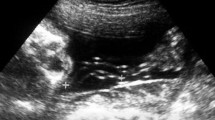Abstract
This is a case report of a pregnant 38-year-old primigravida woman. Due to severe fetal growth restriction and oligohydramnios, she was referred to our tertiary perinatal center at 24 weeks’ gestation. To rule out chromosomal abnormalities and facilitate ultrasound evaluation of fetal morphology, we performed amniocentesis and subsequent amnioinfusion. Thereafter, a precise ultrasound examination revealed no obvious fetal morphological abnormalities except for a hyper-coiled cord and marginal placenta previa. During expectant management, the amount of amniotic fluid was maintained at 20–26 mm for a few days; however, the pregnancy resulted in intrauterine fetal death after 26 weeks + 5 days of gestation. The stillborn infant weighed 530 g (−3.3 SD) and had no obvious external abnormalities apart from umbilical ring constriction. Although a postmortem autopsy was not performed, it is suspected that the fetal growth restriction and the intrauterine fetal death were associated with the hyper-coiled cord and the umbilical ring constriction. It is thought that umbilical ring constriction might therefore be an irreversible fatal condition in cases with a hyper-coiled cord.


Similar content being viewed by others
References
Hasegawa J. Studies for early identification of umbilical cord abnormalities and for managements of high risk pregnancies with them. Acta Obst Gynaec Jpn. 2008;60:1723–34.
Hasegawa J, Matsuoka R, Ichizuka K, et al. Ultrasound diagnosis and management of umbilical cord abnormalities. Taiwan J Obstet Gynecol. 2009;48:23–7.
Skulstad SM, Rasmussen S, Iversen OE, et al. The development of high venous velocity at the fetal umbilical ring during gestational weeks 11–19. BJOG. 2001;108:248–53.
Ghosh A, Woo JS, MacHenry C, et al. Fetal loss from umbilical cord abnormalities—a difficult case for prevention. Eur J Obstet Gynecol Reprod Biol. 1984;18:183–98.
Degani S, Lewinsky RM, Berger H, et al. Sonographic estimation of umbilical coiling index and correlation with Doppler flow characteristics. Obstet Gynecol. 1995;86:990–3.
Rana J, Ebert GA, Kappy KA. Adverse perinatal outcome in patients with an abnormal umbilical coiling index. Obstet Gynecol. 1995;85:573–7.
Strong TH, Jr., Jarles DL, Vega JS, et al The umbilical coiling index. Am J Obstet Gynecol. 1994;170:29–32.
de Laat MW, Franx A, Bots ML, et al. Umbilical coiling index in normal and complicated pregnancies. Obstet Gynecol. 2006;107:1049–55.
Predanic M, Perni SC, Chasen ST, et al. Ultrasound evaluation of abnormal umbilical cord coiling in second trimester of gestation in association with adverse pregnancy outcome. Am J Obstet Gynecol. 2005;193:387–94.
Ezimokhai M, Rizk DE, Thomas L. Maternal risk factors for abnormal vascular coiling of the umbilical cord. Am J Perinatol. 2000;17:441–5.
Ercal T, Lacin S, Altunyurt S, et al. Umbilical coiling index: is it a marker for the foetus at risk? Br J Clin Pract. 1996;50:254–6.
Acharya G, Wilsgaard T, Rosvold Berntsen GK, et al. Umbilical vein constriction at the umbilical ring: a longitudinal study. Ultrasound Obstet Gynecol. 2006;28:150–5.
Hasegawa J, Mimura T, Morimoto T, et al. Detection of umbilical venous constriction by Doppler flow measurement at midgestation. Ultrasound Obstet Gynecol. 2010;36:196–201.
Benirschke K. Recent trends in chorangiomas, especially those of multiple and recurrent chorangiomas. Pediatr Dev Pathol. 1999;2:264–9.
Ogino S, Redline RW. Villous capillary lesions of the placenta: distinctions between chorangioma, chorangiomatosis, and chorangiosis. Hum Pathol. 2000;31:945–54.
Redline RW. Clinical and pathological umbilical cord abnormalities in fetal thrombotic vasculopathy. Hum Pathol. 2004;35:1494–8.
Hofmeyr GJ, Lawrie TA. Amnioinfusion for potential or suspected umbilical cord compression in labour. Cochrane Database Syst Rev. 2012;1:CD000013.
Conflict of interest
The authors have no conflict of interests to declare related to this article.
Author information
Authors and Affiliations
Corresponding author
About this article
Cite this article
Tokunaka, M., Hasegawa, J., Nakamura, M. et al. A case report of umbilical ring constriction with application of amnioinfusion. J Med Ultrasonics 40, 257–260 (2013). https://doi.org/10.1007/s10396-013-0451-6
Received:
Accepted:
Published:
Issue Date:
DOI: https://doi.org/10.1007/s10396-013-0451-6




